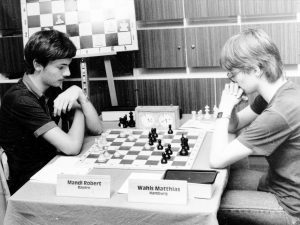In 1984 I almost won the German junior championship (under 20) with the age of 16. In the end I finished shared first place with even the same Buchholz as the champion Peter Meyer. Alas, he was ahead half a refined Buchholz point…. I definitively couldn’t blame bad luck for this, because I had it in my own hands and let the chance slip through my fingers. In the direct encounter with Peter, I achieved a clearly better position but was unable to convert it into a full point. Also in the present game, I emerged with a distinct advantage after the opening, when my opponent fell into a well known trap.

One of the two players desperately needs a new hair cut.
[Event "DJEM"]
[Site "?"]
[Date "1984.??.??"]
[Round "?"]
[White "Mandl"]
[Black "Wahls"]
[Result "1/2-1/2"]
[ECO "B44"]
[Annotator "matthias"]
[PlyCount "64"]
[SourceDate "2002.05.06"] 1. e4 c5 2. Nf3 Nc6 3. d4 cxd4 4. Nxd4
e6 {Diagram [#] Compared to 1982 I had switched to a different repertoire
against 1.e4, because I was very keen on applying a certain Hedgehog setup
(see below). I used exactly this move order here and left White the choice of
continuing either with 5.Nb5, as in the the game, or 5.Nc3 where I would
answer 5..d6. Very often the game then transposed into the
Scheveningen-Variation with 6.Be2 Be7 7.0-0 0-0 8.Be3 Bd7. By developing my
queen's knight before my king's night I stayed clear from the dangerous Keres
Attack (2..e6 3.d4 cd 4.Nd4 Nf6 5.Nc3 d6 6.g4!) which I employed very
successfully with the white pieces throughout my career. As in game 3 that's a good example for move order considerations. Unfortunately, White
has more choices then 6.Be2 such as 6.f4 or 6.Bc4 Nf6 7.Bb3 (Sozin). The most
dangerous dangerous of them appear to be the Velimirovic-Attack (6.Bc4 Nf6 7.
Be3 Be7 8.Qe2) and the English-Attack (6.Be3 Nf6 7.f3).} 5. Nb5 {In my opinion,
this is inferior to 5.Nc3. The ensuing Hedgehog position belongs to one of the
best Black can archive due to the misplacement of the Na3.} d6 {Diagram [#]}
6. c4 {The only alternative is} (6. Bf4 {which was played by Robert Fischer. I
also incorporated it into my White repertoire and even wrote a booklet about
it for Murray Chandler's publishing house. Today I would consider it as
toothless.}) 6... Nf6 7. N1c3 a6 8. Na3 {Diagram [#] From a3 the knight
overprotects c4 and b5, a square to where black would like to push his pawn at
a convenient moment. However, the knight himself his awkwardly placed on the edge
and tends to become a tactical liability there.} (8. Nd4 Bd7 9. Be2 Rc8 {and
Black already threatens 10..Na5.} 10. O-O $2 (10. Nxc6) 10... Na5 11. b3 b5)
8... Be7 9. Be2 O-O 10. O-O b6 {Diagram [#] This was one of my first Hedgehog
games ever, and hence, the beginning of a love affair, which still is alive
until today! I will present you with more Hedgehog games and use these
opportunities to dive deeper into the subject. If I remember correctly, I
already played the Hedgehog in Lugano in 1983, but alas, all my game notations
were lost in one of the many moves I did in my life. Today, I fully rely on
what I can find in the ChessBase online database. There, the earliest games
stem from 1982 (only one tournament) and 1984 (only this very game here).
Basically, everything from 1983 and 1984 is lost.} 11. Be3 Ne5 $1 {White was
threatening to disrupt the harmony of Black's minor pieces by 11.Qb3. Even
though} (11... Bb7 12. Qb3 Nd7 {is playable, the knight on c6 should rather be
placed on f6.}) 12. f3 (12. f4 {is a more aggressive line, which however is
completely okay for Black.}) 12... Bb7 13. Qd2 {Slightly better is} (13. Qb3
Ned7 {which prevents black from countering in the center. However, Black
equalizes in both cases, so the only difference is, that 13.Qb3 prevents the
game from evaporating into a draw, which kind of is the moral duty of white
player. In other words, 13.Qb3 keeps up the appearance that White is still
fighting for an advantage, which in reality he doesn't possess anymore.}) 13...
Qc7 {In a pure scientific sense, Black should rather play the equalizer 13..d5. But I always hated to
play this move, when all I could achieve with it is to force a draw by
simplification. Let's take this confession as a starting point for a small
journey to the psychological meta-level of chess. For most players, including
myself, tournament chess foremost is about scoring the maximum amount of
points. It is not about playing the best move all the time, but the most
efficient one, as a means to an end. Basically, you should always play the move,
which hurts your opponent most. If for example, you play against a stronger
opponent or against one who hates to go for a draw, use the threat of draw as
a weapon! Play the second best move, the one armed with the draw weapon,
and let him make a big concession in order to avoid the draw.} (13... d5 14. cxd5 (
14. exd5 exd5 15. Rfd1 Bxa3 16. bxa3 Nxc4 17. Bxc4 dxc4 18. Qxd8 Rfxd8 19. Bxb6
Rd3 20. Rxd3 cxd3 21. Rd1 Nd5 22. Nxd5 Bxd5 23. Rxd3 Bxa2 $11) 14... exd5 15.
exd5 Nxd5 16. Nxd5 Bxd5 17. Rfd1 Be6 18. Qxd8 Rfxd8 (18... Bxd8 19. Nc2 b5 $11)
19. Bxb6 (19. Rxd8+ Bxd8 $11) 19... Rxd1+ 20. Rxd1 Bxa2 $11) 14. Rac1 {Now it
would be too late for d6-d5, of course. By using the draw weapon, White
achieved a kind of position, which he normally only can get with a misplaced
queen on b3 (see move 13).} Rac8 15. Rfd1 Rfe8 16. Bf1 Qb8 {16..Ned7 is far
more frequently played here, but my move includes a nice trap.} 17. Qf2 $2 {
White steps into it. He should have rather played 17.Kh1, moving his king away
from the dangerous diagonal, or hit on the pawn b6 with unclear play.} (17.
Bxb6 Bxe4 $13) (17. Na4 d5 $5 (17... Nfd7) 18. exd5 exd5 19. Nxb6 Neg4 20. fxg4
Nxg4 21. Bf4 Bc5+ 22. Kh1 Bd6 23. Nd7 Qc7 24. cxd5 Qxd7 {and Black has enough
compensation for the pawn e.g.} 25. Rxc8 Bxc8 26. Bxd6 Qxd6 27. g3 Qe5 28. Nc4
Qh5 29. Rc1 Bb7) 17... d5 $1 {[%csl Ge3,Ge5,Gf2,Gf6] Diagram [#] There are
many circumstances, under which this thematic thrust works out. A very banal
one we saw at move 13. There, I could have played d6-d5 simply because the
square d5 was not controlled by White. Here, the special peace arrangement,
highlighted in green, renders it powerful.} 18. cxd5 (18. Bxb6 dxe4 19. fxe4 (
19. f4 $2 Neg4 20. Qg3 Ba8 (20... Bd6 21. Ne2 e5 22. f5 Rc6 23. c5 Rxb6 $1 24.
cxb6 Bd5 25. Kh1 Qxb6 $19) 21. Bd4 Bd6 22. Ne2 e5 23. fxe5 Nxe5 $19 {White is
lost, because his king is notoriously weak and the pieces lack harmony.} 24.
Qh4 Nd3 25. Rb1 Rcd8 26. Kh1 (26. Bxf6 $1 Bc5+) 26... Be5 27. Be3 Bxh2 28. Qxh2
Qxh2+ 29. Kxh2 Ng4+) 19... Nfg4 20. Qg3 (20. Qe2 $2 Bxe4 (20... Nxh2 $5) 21.
Bd4 Nf3+ $1 22. gxf3 Bxf3 23. Qc2 e5 $19 {The bishop has no good square.} 24.
Bf2 Nxf2 25. Kxf2 e4 {[%cal Rb8h2,Re7c5]}) 20... Bxe4 21. Bd4 Bf5 {[%csl Yb2,
Yc4,Yh2][%cal Gb8b2,Ge7a3,Re7d6,Rd6h2] Black's advantage is claer, if not
winning.} 22. Na4 Rcd8 23. Bxe5 (23. h3 $2 Nf3+ $1) 23... Nxe5 24. c5 Rxd1 25.
Rxd1 Qb4 26. Qxe5 Qxa4 {[%csl Ya3,Yb2,Yc5,Yg1] with many weaknesses in White's
camp.}) 18... Neg4 $2 {Diagram [#] This looked very promising over the board.
Unfortunately, my opponent defended very well and left me only with a slight
advantage. As the analysis shows, it was more accurate to recapture on d5
first:} (18... exd5 19. Nxd5 (19. h3 {(preventing Ng4)} dxe4 20. Nxe4 Bxe4 21.
fxe4 Rxc1 22. Rxc1 b5 23. Qf5 Bd6 $17) (19. exd5 Neg4 20. fxg4 Nxg4 21. Qg3
Nxe3 22. Qxb8 {Here you see the difference compared to the game. White is
forced to swap queens himself, which shifts my rook from d8 to c8. Thus,
the fork d6-d7, which came up as a motif in the game, does not longer exist.} (
22. d6 Nf5 $19) 22... Rxb8 23. Rd3 Rbd8 $19) 19... Bxd5 20. exd5 Neg4 21. fxg4
Nxg4 22. Qg3 Qxg3 23. hxg3 Rxc1 {Again, this possibility removes the motif
d6-d7!} 24. Rxc1 Nxe3 25. Bxa6 Bc5 26. Kh1 Nxd5 27. Bb7 Nb4 28. Rd1 Kf8 29. Kh2
Nxa2 $17) 19. fxg4 Nxg4 20. Qg3 Qxg3 21. hxg3 Nxe3 22. d6 $1 (22. Re1 Bc5 23.
Kh1 exd5 24. exd5 b5 $19) 22... Nxd1 23. Rxd1 Rxc3 (23... b5 24. dxe7 b4 25.
Nc4 bxc3 26. Nd6 cxb2 27. Rb1 Rxe7 28. Nxc8 Bxc8 29. Rxb2 Kf8 30. Rb8 Re8 31.
Rb6 Ke7 32. Bxa6 Bxa6 33. Rxa6 Kf6 $15) (23... Rcd8 24. dxe7 Rxd1 25. Nxd1 Rxe7
26. Bd3 Rd7 27. Nf2 b5 $15) (23... Bg5 $4 24. d7) 24. bxc3 Bg5 25. e5 $1 (25.
Kf2 $2 Rc8) 25... Be3+ $2 {The bishop should have better not abandoned the
coverage of d8, thus allowing the rook to become active along the c-file:} (
25... Rc8 26. Nc4 (26. d7 Rd8 27. Nc4 b5 28. Na5 Bd5 29. c4 bxc4 30. Bxc4 Rxd7)
(26. Nb1 Rc5) 26... Bd8 27. d7 Rc7 28. Rd6 (28. Nxb6 Rxc3 29. Nc4 Kf8) (28. Rb1
b5 29. Nd6 Bd5 30. c4 bxc4 31. Rb8 Rxd7 32. Nxc4 Bxc4 33. Bxc4 g6 34. Bxa6 Kg7
$15) 28... Kf8 29. Rxb6 Rxd7 30. Rb3 f6 $15) 26. Kh2 $13 Bc5 (26... b5 27. c4
b4 28. Nc2 Bc5 29. Ne1 $13) 27. Nc4 Bd5 (27... f6 $2 28. Nxb6 Bxb6 29. Rb1) 28.
a4 Kf8 29. a5 $2 (29. Nd2 Ra8 30. Bd3 $11) 29... b5 30. Nb2 (30. Nb6 Bxb6 31.
axb6 Rb8 32. c4 bxc4 33. Rc1 Rxb6 34. Bxc4 Bc6 35. Ra1 Ke8 36. Bxa6 Kd7 37. Bc4
f6 $15) 30... Bb3 $6 (30... Ba3 31. Nd3 Rc8 32. Nf4 Bc6 33. Nd3 Bb7 34. Nb4
Bxb4 (34... Bb2 35. Na2) 35. cxb4 Bd5 36. Rd2 f6 $15) 31. Rd2 f6 $2 (31... Be3
32. Re2 (32. Rd3 $2 Bc1 33. Nd1 f6 $17) 32... Bg5 $15) 32. Nd3 $2 (32. c4 bxc4
33. Nxc4 $11) 32... Ba3 {I don't know anymore why I offered a draw in this
position. In case of doubt, I should be slightly better here again. Either I
was in time trouble or disappointed about the course of the game.} 1/2-1/2Recommended Posts
